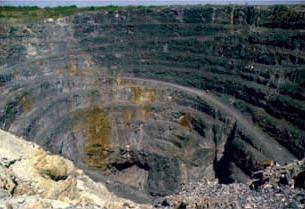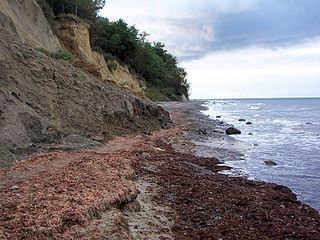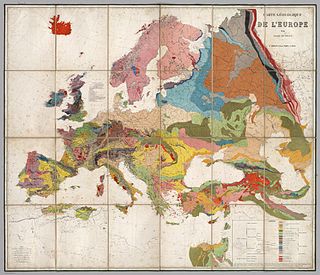
A mountain range or hill range is a series of mountains or hills ranged in a line and connected by high ground. A mountain system or mountain belt is a group of mountain ranges with similarity in form, structure, and alignment that have arisen from the same cause, usually an orogeny. Mountain ranges are formed by a variety of geological processes, but most of the significant ones on Earth are the result of plate tectonics. Mountain ranges are also found on many planetary mass objects in the Solar System and are likely a feature of most terrestrial planets.
The Neogene is a geologic period and system that spans 20.45 million years from the end of the Paleogene Period 23.03 million years ago (Mya) to the beginning of the present Quaternary Period 2.58 Mya. The Neogene is sub-divided into two epochs, the earlier Miocene and the later Pliocene. Some geologists assert that the Neogene cannot be clearly delineated from the modern geological period, the Quaternary. The term "Neogene" was coined in 1853 by the Austrian palaeontologist Moritz Hörnes (1815–1868).

Physical geography is one of the two major sub-fields of geography. Physical geography is the branch of natural science which deals with the study of processes and patterns in the natural environment like the atmosphere, hydrosphere, biosphere, and geosphere, as opposed to the cultural or built environment, the domain of human geography.

The Nineteenth Amendment to the United States Constitution prohibits the states and the federal government from denying the right to vote to citizens of the United States on the basis of sex. It was adopted on August 18, 1920.
Klassekampen is a Norwegian daily newspaper, which styles itself as "the daily left-wing newspaper".

Volcanogenic massive sulfide ore deposits, also known as VMS ore deposits, are a type of metal sulfide ore deposit, mainly copper-zinc which are associated with and created by volcanic-associated hydrothermal events in submarine environments.

A rockfall or rock-fall refers to quantities of rock falling freely from a cliff face. The term is also used for collapse of rock from roof or walls of mine or quarry workings. A rockfall is a fragment of rock detached by sliding, toppling, or falling, that falls along a vertical or sub-vertical cliff, proceeds down slope by bouncing and flying along ballistic trajectories or by rolling on talus or debris slopes,”. Alternatively, a "rockfall is the natural downward motion of a detached block or series of blocks with a small volume involving free falling, bouncing, rolling, and sliding". The mode of failure differs from that of a rockslide.

The Leser-Trélat sign is the explosive onset of multiple seborrheic keratoses, often with an inflammatory base. This can be an ominous sign of internal malignancy as part of a paraneoplastic syndrome. In addition to the development of new lesions, preexisting ones frequently increase in size and become symptomatic.
Leser v. Garnett, 258 U.S. 130 (1922), was a case in which the Supreme Court of the United States held that the Nineteenth Amendment to the United States Constitution had been constitutionally established.
Norbert Leser was an Austrian jurist, political scientist and social philosopher best known for his lifelong affiliation with, and critical work on, the Social Democratic Party of Austria and Austromarxism in particular. He was born in Oberwart and died in Eisenstadt.

The Spirit River Formation is a stratigraphical unit of middle Albian age in the Western Canadian Sedimentary Basin.

A gat is a strait that is constantly eroded by currents flowing back and forth, such as tidal currents. It is usually a relatively narrow but deep, up to 30 m (100 ft) passage between land masses or shallow bars in an area of mudflats. A gat is sometimes a shallower passage on lagoon coasts, including those without any tidal range.

A wash margin or wash fringe is an area of the shore on which material is deposited or washed up. It often runs along the margin of a waterbody and there can be several bands due to variations in water levels. As a result of the richness of nutrients that occur in such wash fringes, ruderal species frequently occur here, that, for example, on the Baltic Sea coast consist of grassleaf orache and sea kale.
Paul Leser was a German-American ethnologist.

An interfluve is a narrow, elongated and plateau-like or ridge-like landform between two valleys. Whittow, more generally, defines an interfluve as an area of higher ground between two rivers in the same drainage system.

A cirque stairway or sequence of cirque steps is a stepped succession of glacially eroded rock basins. Their individual formation is that of a cirque.
Tina Leser was an American fashion designer. Part of a generation of pioneering sportswear designers, Leser was particularly known for her global influences.

The head of the valley or, less commonly, the valley head, refers to the uppermost part of a valley.













